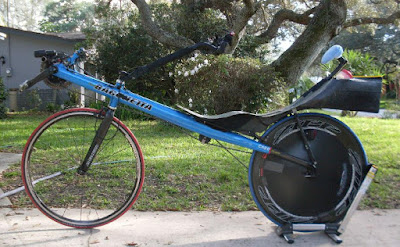


The mini bullhorn handlebar that I used on the tiller was not `mini' enough. The steering with the tiller and mini bullhorn was rock solid, nonetheless. Brakes, R2C levers ... excellent.
In order to reduce wind drag and to make it even more comfortable I reduced the width of the bullhorn handlebar by 60 mm, i.e., 30 mm from either side of the section onto which the tiller clamps. I then had it welded together again.
The pic above is the before and after.
I think I'm in the final stages of recovery from a three week bout of the most mysterious flu. Started out like most flu episodes (head filled with snot, coughing), then moved into laryngitis and finally persisted as two weeks of low energy and high need for sleep.
With ten days to a 12 hour time trial at Borrego Springs I finally got back on the bike for a quick up'n'over the Bradshaw mountain on the White Spar.
Kept it low and slow most of the way. The conditions were good for fast descents, though. On the last 2.5 miles of the ride it is all downhill and switchbacks. Glass smooth road. Posted speed limit ranges between 30 - 45 mph.
As I began the descent I noted a car about 30 yards behind me preparing to pass. Usually I just pull over and wave the vehicle past so that I don't have to deal with the hassle. This time, however, I was having just too much fun, and knowing I wasn't going to overtrain on the descent. So I pushed it.
Riding the Spars
For the first 100 yards I pedaled hard to get to `escape velocity.' Then I assumed the `luge' position and took advantage of the 4 - 6 degree angle of descent. With the combination of the luge and tucking tightly I was able to accelerate to 45 mph as I approached the first `gentle' curve. The car behind became distant as it complied with the 30 mph limit.
For the next mile I continued the luge and the tuck. When my speed reduced to 38 mph I engaged the pedals again and cranked hard and fast (115-120 rpm due to the fact that my big ring on the Ti Aero is only a 50t).
I expected the car behind to pass me but I think he was having a good time watching me have a good time. He stayed well behind me all the way to the end.
That was fun.
A year and a half ago I modified my Ti Aero and CA2 steering setup from a stock riser and handlebar to a tiller and stem.
This is a pic of the stock riser and handlebar setup:
I found that the riser impeded my ability to see ahead of me. That was the primary basis of my interest in the Cruzbikes. This is a pic of one of the three (Vendetta, Silvio and Sofrider) Cruzbikes I owned (Silvio):
The front wheel drive of the Cruzbike is problematic for me for several reasons I won't describe here. I returned to the Bacchetta stick bike frame and rear wheel drive.
I then became interested in a different bike that had both a tiller setup and rear wheel drive, the M5 Carbon High Racer (pic):
But I chose against this bike for two reasons: didn't want to spend the money and the chain interferes with right hand turning (wheel hits the chain). In my terrain the fast, descending switchbacks would pose a problem with the chain / wheel issue.
My compromise response was to modify the Bacchetta bikes I have to obtain a) the tiller and stem setup, b) a much more reclined seat, c) retain the rear wheel drive. This is a picture of Kent Polk's initial use of the tiller, stem and custom make reclined carbon fiber hard shell seat:
I ordered from Kent the Railgun seat for both my Bacchetta bikes. It makes a profound beneficial difference. I then ordered the tiller and stem setup from Performer Bikes in Taiwan.
Others using the Performer Bikes tiller and stem modified it so that it angled down to the level of recline the rider wants for the Railgun seat. So that the tiller stops, and doesn't land in your lap, others had drilled a hole in the stem and inserted a strong bolt. This is a pic:
Two things to note on the picture above. First, in order to get the angle at which the tiller `fits' the rider's preference I had to tap several holes, experimenting. Second, given that I didn't want the strong bolt hitting the stop point on the stem (metal on metal) I had to `cushion' the stop point with pieces of strong rubber, lashed to the stem with cable ties.
Quickly I concluded that the bolt, rubber and cable ties was not a long-term solution. In fact, after a long and dangerous cycling event (Hoodoo 300) the bolt simply fell out on a training ride.
To eliminate this problem I welded a piece of aluminum to the tiller and welded an aluminum channel into which I inserted a `soft' stop (again, strong rubber):

I am able to adjust the angle at which the tiller stops simply by adjusting the length of the rubber inserted into the stem channel. The rubber is firm and snug in the channel eliminating the possibility of falling out.
You will also note that I welded the tiller itself to the stem. Previously it had been attached to the stem with a simple seat clamp. That is problematic. The seat clamp can loosen and the tiller and handlebars can swivel, completely eliminating steering control.


















